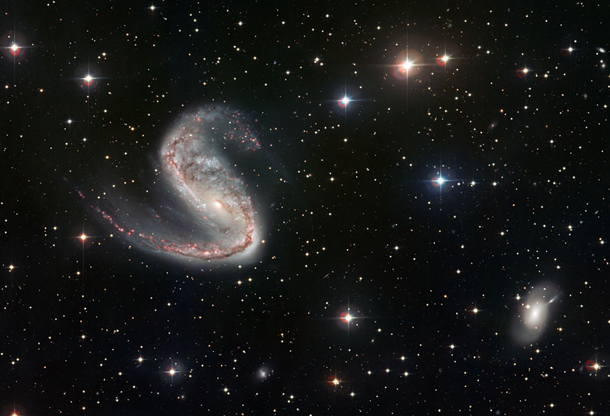My love affair with spiral galaxies is well documented here on this blog. Of course, I’m biased: I live in one.
But some of them demand a little more attention than others, like the oddly off-kilter NGC 2442, aka the Meat Hook Galaxy:
 That gorgeous image (click to galactinate, or grab the ginormous 6756 x 5687 pixel version) is from the MPG/ESO 2.2 meter telescope in Chile, and it definitely shows why NGC 2442 is a weird one. The one arm at the bottom is long and stretched out, the top one is thicker and dotted with pink star-forming regions, and the nucleus is way off-center. What the heck happened to this galaxy?
That gorgeous image (click to galactinate, or grab the ginormous 6756 x 5687 pixel version) is from the MPG/ESO 2.2 meter telescope in Chile, and it definitely shows why NGC 2442 is a weird one. The one arm at the bottom is long and stretched out, the top one is thicker and dotted with pink star-forming regions, and the nucleus is way off-center. What the heck happened to this galaxy?
Perhaps a close-up by Hubble will help:
[Note: this image is rotated 180° from the one above.] Again, we see lots of red gas clouds glowing, fired up by massive stars forming in them. Interestingly, to me this view of the galaxy looks like a single bird feather, with the individual vanes arcing down. Those vanes are actually streamers of gas and dust pulled out like taffy from the main arm. Given all this, it’s pretty clear that NGC 2442 suffered a very close pass or even a collision with another galaxy sometime in the relatively recent past.
But what galaxy? In the first image above you can see a small spiral galaxy off to the right. But in a much wider-scale image (reversed left to right of the one here) there is another galaxy above NGC 2442. It may have been either of these two… but I have my suspicions it’s the one on the right. In the first picture above, see how the small galaxy has no red star-birth regions in it? Many times, when smaller galaxies ram through big ones, all their gas and dust is stripped out by the bigger galaxy. The lack of gas in the small spiral is something of a tell.
In the Hubble image you can actually see smaller galaxies right through NGC 2442, too! That always gets me. So cool. But those are almost certainly much more distant background galaxies – NGC 2442 is roughly 50 million light years away, and those are more like hundreds of millions of light years distant. Even if they are near NGC 2442, they’re too small to have caused such a major disruption of the far larger galaxy anyway.
I’ll note that a radio survey of this region also detected a huge cloud of neutral hydrogen near NGC 2442 with about a billion times the mass of the Sun! That fits; it was probably free-floating hydrogen in the galaxy that got drawn or blown out by the passage of the smaller galaxy.
Pristine, symmetric spirals are so beautiful, but they are also lovely to behold when disrupted by a catastrophic collision, too. The energies and scales involved are mind-numbing, yet from a distance, and apparently frozen in time, they still possess a majesty and grand beauty.
Image credits: ESO; NASA/ESA and ESO
Related posts:
- Gorgeous galaxies celebrate Hubble’s 21st birthday
- When science and beauty collide
- Awesome Antennae!
- Felicia Day collides galaxies!